
Hylidae is a wide-ranging family of frogs commonly referred to as "tree frogs and their allies". However, the hylids include a diversity of frog species, many of which do not live in trees, but are terrestrial or semiaquatic.

Sphaenorhynchus is a genus of frogs in the family Hylidae. They are also known as lime treefrogs or hatchet-faced treefrogs. They are found in the Amazon and Orinoco River basins of South America, the Guianas, Trinidad, and southern and eastern Brazil. The majority of the species are associated with the Atlantic Forest domain in Brazil.

Pseudis is a genus of South American frogs in the family Hylidae. They are often common and frequently heard, but easily overlooked because of their camouflage and lifestyle, living in lakes, ponds, marshes and similar waters with extensive aquatic vegetation, often sitting at the surface among plants or on floating plants, but rapidly diving if disturbed. Whereas the adults are medium-sized frogs, their tadpoles are large; in some species the world's longest.

Pseudis paradoxa, known as the paradoxical frog or shrinking frog, is a species of hylid frog from South America. Its name refers to the very large—up to 27 cm (11 in) long—tadpole, which in turn "shrinks" during metamorphosis into an ordinary-sized frog, only about a quarter or third of its former length. Although the recordholder was a tadpole in Amapá that belonged to this species, others in the genus Pseudis also have large tadpoles and ordinary-sized adults.
The Hispaniolan yellow tree frog, or common treefrog, is a species of frog in the family Hylidae endemic to Hispaniola, where it is found in both the Dominican Republic and Haiti.
The Alhandra heart-tongued frog is a species of frog in the family Hylidae endemic to Brazil. It has been observed as high as 100 meters above sea level.
Phyllodytes punctatus is a species of frogs in the family Hylidae endemic to Brazil. People have seen it as high as 140 meters above sea level.

Pithecopus rohdei, also known as Rohde's leaf frog, Rohde's frog, and Mertens' leaf frog, is a species of frog in the subfamily Phyllomedusinae. The species was previously placed in the genus Phyllomedusa. The species is endemic to southeastern Brazil and occurs at elevations up to 1000 meters above sea level.

Pseudis bolbodactyla is a species of frog in the family Hylidae. It is endemic to southern Brazil and occurs in Minas Gerais, southern Goiás, southern Bahia, and northern Espírito Santo states. Although it is currently considered a valid species, it has also been treated as a subspecies of Pseudis paradoxa.

Pseudis cardosoi is a species of aquatic frog in the family Hylidae. It is endemic to southern Brazil and is known from the states of Rio Grande do Sul, Santa Catarina, and Paraná. The specific name cardosoi honors Adão José Cardoso, a Brazilian herpetologist.
Pseudis fusca is a species of frog in the family Hylidae. It is endemic to Minas Gerais, Brazil, and only known few localities. Although it is currently considered a valid species, it has also been treated as a subspecies of Pseudis paradoxa.

Pseudis minuta is a species of aquatic frog in the family Hylidae. It is found in northeastern Argentina, Uruguay, and southern Brazil, and is likely to be found in southern Paraguay.
Pseudis tocantins is a species of aquatic frog in the family Hylidae. It is endemic to central Brazil and occurs in the eponymous state of Tocantins, as well as in Goiás, Mato Grosso, and Maranhão states, in the Tocantins and Araguaia River basins.

Stefania evansi is a species of frog in the family Hemiphractidae. Stefania evansi is, along with other closely related frogs, known for its unusual reproductive mode where females carry the eggs and juveniles on their back. It is sometimes known under common names Groete Creek carrying frog, Groete Creek treefrog, or Evans' stefania. These names refer to its type locality, Groete Creek in the region Essequibo Islands-West Demerara, Guyana, where the holotype was collected by one Dr. R. Evans.

Phyllodytes maculosus is a species of frogs in the family Hylidae endemic to Brazil's rainforests. It has been observed between 77 and 837 meters above sea level.

Hylinae is a large subfamily of "tree frogs", family Hylidae.

Dendropsophini is a tribe of small neotropical tree frogs in the subfamily Hylinae. They are distributed from southern Mexico, throughout Central America, and down South America to northern Argentina and Uruguay. Removed from the synonymy of Hylinae in 2016, this taxon was formerly considered its own subfamily before being reclassified as a tribe. As defined by Favovich et al. in 2005, the tribe Dendrosophini contains the members of three former subfamilies within the Hylidae prior to taxonomic rearrangement: Dendropsophinae, Pseudinae, and Scinaxinae.
Ecnomiohyla sukia, the shaman fringe-limbed tree frog, is a frog in the family Hylidae. It is endemic to Costa Rica. It has been observed between 400 and 1000 meters above sea level.
Ecnomiohyla bailarina, the golden-eyed fringe-limbed tree frog, is a frog in the family Hylidae, endemic to Panama and Costa Rica. Scientists have seen it between 400 and 1400 meters above sea level. It lives in the Talamanca Mountains in Costa Rica and in Santa Fé National Park in Panama.











